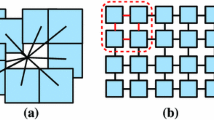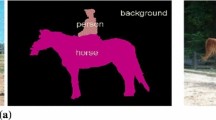Abstract
An object can often be uniquely identified by its shape, which is usually fairly invariant. However, when the search is for a type of object or an object category, there can be variations in object deformation (i.e. variations in body shapes) and articulation (i.e. joint movement by limbs) that complicate their detection. We present a system that can account for this articulation variation to improve the robustness of its object detection by using deformable shapes as its main search criteria. However, existing search techniques based on deformable shapes suffer from slow search times and poor best matches when images are cluttered and the search is not initialised. To overcome these drawbacks, our object detection system uses flexible shape templates that are augmented by salient object features and user-defined heuristics. Our approach reduces computation time by prioritising the search around these salient features and uses the template heuristics to find truer positive matches.
Similar content being viewed by others
References
Bern, M.W., Eppstein, D.: Mesh generation and optimal triangulation. In: Du, D.Z., Hwang, F.K.M. (eds.) Computing in Euclidean Geometry, 2nd edn. Lecture Notes Series on Computing, vol. 4, pp. 47–123. World Scientific, Singapore (1995) http://www.ics.uci.edu/~eppstein/pubs/BerEpp-CEG-95.pdf
Chang, T.L., Liu, T.L.: Detecting deformable objects with flexible shape priors. In: ICPR ’04: Proceedings of the Pattern Recognition, 17th International Conference on (ICPR’04), vol 4, pp. 155–158. IEEE Computer Society, Washington, DC (2004) Doi:10.1109/ICPR.2004.291
Dia: (2006) http://www.gnome.org/projects/dia
Felzenszwalb, P.F.: Representation and detection of deformable shapes. CVPR 1, 102–108 (2003) http://citeseer.ist.psu.edu/felzenszwalb03representation.html
Felzenszwalb P.F. (2005). Representation and detection of deformable shapes. IEEE Trans. Pattern Anal. Mach. Intell. 27(2): 208–220 Doi:10.1109/TPAMI.2005.35
Feraud R., Bernier O.J., Viallet J.E. and Collobert M. (2001). A fast and accurate face detector based on neural networks. IEEE Trans. Pattern Anal. Mach. Intell. 23(1): 42–53 Doi:10.1109/34.899945
GIMP: (2006) http://www.gimp.org
Kass, M., Witkin, A., Terzopoulos, D.: Snakes: active contour models. Int. J. Comput. Vis. 1(4), 321–331 (1988) Doi:10.1007/BF00133570. http://dx.doi.org/10.1007/BF00133570
Ke, Y., Sukthankar, R.: Pca-sift: a more distinctive representation for local image descriptors. In: Computer Vision and Pattern Recognition, 2004. CVPR 2004. Proceedings of the 2004 IEEE Computer Society Conference on, vol. 2, pp. II–506–II–513, vol.2 (2004). Doi:10.1109/CVPR.2004.1315206
Lamdan, Y., Schwartz, J., Wolfson, H.: Object recognition by affine invariant matching. In: Computer Vision and Pattern Recognition, 1988. Proceedings CVPR ’88., Computer Society Conference on, pp. 335–344 (1988) Doi:10.1109/CVPR.1988.196257
Li, W.J., Lee, T.: Image registration and object recognition by affine invariant matching. In: Intelligent Multimedia, Video and Speech Processing, 2001. Proceedings of 2001 International Symposium on, pp. 56–59 (2001) Doi:10.1109/ISIMP.2001.925330
Mohan A., Papageorgiou C. and PoggioT. (2001). Example-based object detection in images by components. IEEE Trans. Pattern Anal. Mach. Intell. 23(4): 349–361 Doi:10.1109/34.917571
OpenCV: (2006) http://sourceforge.net/projects/opencv
Osuna, E., Freund, R., Girosit, F.: Training support vector machines: an application to face detection. In: Computer Vision and Pattern Recognition, 1997. Proceedings, 1997 IEEE Computer Society Conference on, pp. 130–136 (1997) Doi:10.1109/CVPR.1997.609310
Thuresson, J., Carlsson, S.: Finding object categories in cluttered images using minimal shape prototypes. In: SCIA, pp. 1122–1129 (2003)
Verschae R. and del Solar J.R. (2003). A Hybrid Face Detector Based on an Asymmetrical Adaboost Cascade Detector and a Wavelet-Bayesian-Detector. Springer, Berlin
Viola P. and Jones M.J. (2004). Robust real-time face detection. Int. J. Comput. Vision 57(2): 137–154 Doi:10.1023/B:VISI.0000013087.49260.fb
Xiao, R., Zhu, L., Zhang, H.J.: Boosting chain learning for object detection.In: Computer Vision, 2003. Proceedings. 9th IEEE International Conference on, vol. 1, pp. 709–715 (2003). Doi:10.1109/ICCV.2003.1238417
Yezzi A.J., Kichenassamy S., Kumar A., Olver P. and Tannenbaum A. (1997). A geometric snake model for segmentation of medical imagery. Med. Imaging, IEEE Trans. 16(2): 199–209. Doi:10.1109/42.563665
Author information
Authors and Affiliations
Corresponding author
Rights and permissions
About this article
Cite this article
Smith, R., Pham, B. A robust object category detection system using deformable shapes. Machine Vision and Applications 20, 119–130 (2009). https://doi.org/10.1007/s00138-007-0112-0
Received:
Revised:
Accepted:
Published:
Issue Date:
DOI: https://doi.org/10.1007/s00138-007-0112-0




